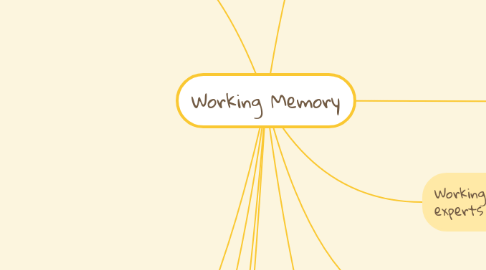Working Memory
af Will Lawson

1. Guidelines
1.1. Anything goes!
1.2. No criticism or flaming allowed
1.3. The Wilder The Better
1.4. Quantity is Quality
1.5. Set a Time Limit
2. Evolution of Working memory
2.1. Phineaus Gage a railway worker: was setting explosive charges when a spark was created from packing in the charges and ignited the gunpowder sending a metal iron rod through his left cheek and into his brain. pg 3
2.1.1. Scientists learned that the damage to his brain dramatically affected his mood and he was a completely different person after the accident. It was after this event that scientists realised the effect the brain has on behaviour. pg 3
2.2. Working Memory is the brains conductor. Like a conductor, it brings together all of the different areas and functions of the brain into harmony. In the same way, the brain is like an orchestra, with each area like a different section. The language center, Broca's area, is like the articulate expressiveness of the string section. The intraparietal sulcus, the math area, is like the precise keyboard section. The amygdala, the heart of our emotions, is like the thundering percussion section that must be brought under control or it will overpower the whole orchestra. Without its conductor, the orchestra makes the jarring sounds of a cacophony. It is not until working memory walks on stage that all instruments are brought under control, and the symphony can begin pg 4
2.3. pg 5 In the 1870s, the Scottish brain scientist David Ferrier discovered where working memory was located in the brain. This discovery was made possible by the concept of localization. Localisation means that we can map the brain according to what it does. It was in the nineteenth century that the medulla oblongata was linked to respiration, the cerebellum was linked to equilibrium, and the language centers of the brain were discovered
2.4. pg 6 Many advances in ninteenth century brain science were made possible by the use of techniques like ablation- cutting a piece of brain out to see what ability would be affected - and galvanic stimulation 0 attaching an electrical conductor to an exposed section of brain to stimulate it.
2.5. Baddeley and Hitch Working Memory Model 1974
3. Sleep Deprivation and performance
4. Working Memory and addictive behaviour
5. Working Memory Training
5.1. Given the relevance of working memory to daily life and educational settings, it is not surprising that a current major topic in Cognitive Science is the development of Working Memory interventions (see Buschkuehl &Jaeggi, 2010; Klingberg, 2010; Lustig, Shah, Seidler, & Reuter-Lorenz, 2009; Shipstead, Redick, & Engle, 2010 for reviews).
5.2. One of the aims in those interventions is not only to train participants' Working Memory skills, but also to obtain generalizing effects that go beyond the trained domain, and effect which is termed "transfer."
5.3. Transfer : in order to get a sense of what is meant by transfer, consider the following analogy: Physical training not only has an effect on trained activities, but also on activities that are not explicity trained. For example running on a regular basis can increase biking performance ( Suter, Marti, & Gutzwiller, 1994), but more generally, running will improve perfomance on any activity that benefits from an efficient cardiovascular system and strong leg muscles, such as climbing stairs or swimming.
5.4. from Book: Working Memory - The Connected Intelligence Edited by Tracy Packiam Alloway and Ross G. Alloway pg 277-286
6. French Philosopher Rene Descartes "Cogito ergo sum" : meaning. - I think therefore I am
7. Working Memory What is it
7.1. The cognitive mechanism that supports active maintenance of task-relevant information during the performance of a cognitive task
7.2. Working Memory is predictive for a wide range of complex cognitive tasks such as planning and problem solving (Shah & Miyake, 1999), also school-relevant tasks such as reading comprehension and math.
7.3. Working Memory capacity is crucial for our general ability to acquire knowledge and learn new skills (Pickering, 2006)
7.4. from Book: Working Memory - The Connected Intelligence Edited by Tracy Packiam Alloway and Ross G. Alloway pg 277-286
7.5. The ability to moderate our emotions, to control what we say and do, to form a plan and execute it, to do mental math, to perceive the needs of others, to focus on the positive and disregard the negative, to quickly shift between tasks, to write and carry on a conversation, to put names together with faces, all would be impossible without working memory. No wonder Phineas changed. pg 4
8. Working Memory and Intellegince
9. Working memory that mediates experts performance
10. Working Memory and Meditation
11. Insights on Working Memory from Neuroimaging
11.1. Cardiovascular training increases gray and white matter volume and/or integrity, especially in older participants who were sedentary before the training program. (e.g. Bugg & Head, 2001; Bullitt et al., 2009; Colcombe et al., 2006; Erickson et al., 2011)
11.2. In fact, prefrontal regions strongly associated with the executive functions of working memory (see Hillman et al., 2008 for review) are among those most sensitive to cardiovascular fitness.



